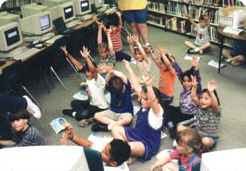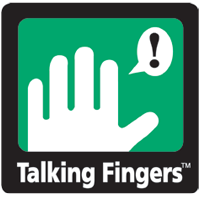FAQs
Frequently Asked Questions about the
Read, Write & Type

Q: Can first graders handle keyboarding?
Q: How will the Read, Write & Type help my child?
Q: How does the Read, Write & Type compare with other reading methods?
Q: Does the Read, Write & Type work for children of different ability levels?
Q: Can I assess my child's progress within the Read, Write & Type?
Q: Can the Read, Write & Type be used with ESL and bilingual students?
Q: Why is the Read, Write & Type so successful?
Frequently Asked Questions about Wordy Qwerty – from Talking Fingers, Inc.
Q. What uniquely sets Wordy Qwerty apart from the hundreds of software reading products?
A. Wordy Qwerty — Foundations for Reading and Writing Fluency, demystifies spelling and makes it fun to learn to write and read words. It capitalizes on the importance of spelling as an essential component of reading and writing fluency.
Wordy Qwerty is targeted at 7 to 10 year olds who have learned the basics of phonics and word identification and are poised to master more complex reading and writing skills in order to become enthusiastic and capable readers and writers. It uniquely uses a writing-to-read approach in order to provide individualized feedback and to activate and connect essential areas of the brain.
Two engaging characters, Midi the musician and Qwerty the word coach, enlist children to help them accumulate the “spheres” that are needed to play Midi’s music machine. Children do this by successfully mastering six activities in each of twenty lessons. They learn to recognize patterns in words, type to dictation, write and read stories, and listen to and sing songs that will help them remember how words are spelled and pronounced and what they mean.
Q. Where can I go to get a quick demo of Wordy Qwerty?
A. Click here
Q. Can any 7 to 10 year old child pick up and use Wordy Qwerty?
A. Yes, any 7 to10 year old can use the program. They’ll do even better if they’ve learned keyboarding, phonemic awareness and basic spelling conventions first, with our flagship Read Write & Type program.
Q. Many reading products claim to be research-based; Why is that important?
A. It’s important for developers of reading products to base their products on the latest and most reliable reading research. It is also important to find out whether the product they have created really works to help children learn to read. This can only be determined via well-designed classroom research, with a variety of children using the product. The most current research in reading has found that, to become successful, fluent readers, children need phonics-based instruction that is systematic and explicit, with ample opportunity for individualized instruction and feedback. For fluency and comprehension, they need to develop strategies that use a knowledge of how words are constructed in English. Talking Fingers has incorporated these principles into its approach of using writing as a route to reading.
Q. Is Wordy Qwerty research-based?
A. Yes. Research with Wordy Qwerty was conducted by reading specialists at Southern Methodist University, in Dallas, Texas, as part of the development of the program.
Wordy Qwerty‘s creator, Dr. Jeannine Herron, Ph.D., has 30 years experience in brain and reading research. Her approach has been tested and proven successful through research using Read Write & Type, in public schools across California, as well as through research by noted reading specialist, Joseph Torgesen, at Florida State University. Research with both Read Write & Type and Wordy Qwerty have been funded by private foundations as well as the National Institute of Child Health and Human Development (NICHD).
Q. What will children get out of Wordy Qwerty?
A. Researchers report that fluent readers and writers access the words they read and write from a “database” located in the left hemispheres of their brains. This database stores both the sounds and meanings of the words we read and write. Wordy Qwerty helps children build and automatically access this invaluable left-brain data. They see, hear and type scores of words, individually, in sentences, and in stories. They store the motor memory of typing, and the sound, sight and meaning of each word in their brains, for future reference.
Wordy Qwerty uses games, songs, rhymes, storytelling and rewards to teach children 20 spelling rules, introduce them to word families, and identify the “outlaw words” (words that do not conform to spelling conventions and must simply be memorized by sight). As they master these concepts, the world of reading and writing widens beyond belief. Children fearlessly and confidently tackle new words because they have learned the rules and strategies that will help them succeed. The skills Wordy Qwerty fosters will remain embedded throughout their lifetime.
Q. What is the Talking Fingers, Inc. approach to reading and writing?
A. The Talking Fingers approach to reading and writing is based on a simple idea: Text is speech made visible. We use our mouths to talk, to make the sounds of words. We use our fingers (with a pencil or keyboard) to represent those sounds on paper.
There are roughly 40 sounds (or phonemes) in English. It takes only 26 letters to stand for those sounds, to make any spoken word visible. When children learn to link those sounds with letters, they can use the alphabet code to write any word they can say. Their fingers are “talking”.
Writing (encoding words), is a natural, speech-based route to reading. Each word has to be mentally pronounced and then spelled out one sound at a time. Children store this new database of word information near brain areas where speech and language comprehension are already stored. As children write, their mouths may be quiet, but their brains and their fingers are “talking.”
Q. Can you tell me a little about the product's creator?
A. Dr. Jeannine Herron has been involved in children’s education since 1955. This mother of two, and grandmother of five, has been teacher, activist, research scientist, adventurer, editor, writer, and educational software developer, and shows no signs of slowing down.
She began her career as an American teacher in the mid-fifties, teaching English, Mathematics, and General Science to middle and high school students in Ramallah, Jordan. Seven years later, she and her husband, and their two small children moved to Mississippi to be active in the civil rights movement. It was there that Jeannine became Co-founder and Program Director of the first Head Start project in the United States, the Child Development Group of Mississippi, an organization that served over 5,000 children.
Jeannine received her Ph.D. from Tulane University Medical School, and went on to Stanford Research Institute as a neurobiologist and neuropsychologist. In 1974, she moved to UCSF and was awarded a research fellowship from the National Institute of Health (NIH) to investigate the cerebral organization in left-handers, Her first book, Neuropsychology of Left-Handedness, was published by Academic Press in 1980. From 1976 to 1984 she continued at UCSF as research psychologist, contributing to all aspects of a large NIH-funded project studying dyslexia.
In 1982, she founded a non-profit organization for educational research that has produced more than 50 conferences across the U.S. to inform professionals in health, psychology and education about relationships between the brain and learning. She developed and carried out research with two major software programs funded largely by the National Institute for Child Health and Human Development (NICHD). She is still actively involved in lecturing and providing professional development for teachers.
Her experiences with children in Mississippi, her history in the classroom, her research in dyslexia, and her discoveries from teaching her own children to write, fueled her desire to develop practical tools to help children learn to read and write.
Frequently asked questions about Talking Shapes
Q: Can I use this app on a tablet as well as a computer?
A: Yes, the seven Talking Shapes apps are downloadable from the Apple Store, Google Play and the Amazon Store. It is also possible to purchase licenses from our website for the browser-based online app for computers. Soon, if you purchase online licenses, you will be able to play Talking Shapes through a browser on your tablet
Q: Does the app have an assessment component?
A: Yes. On the browser-based online apps for computers, Talking Shapes has assessment built in, and the teacher or parent can view the child’s progress. The apps flow from one lesson to the next, with assessments after Apps 3,5 and 7.
Q: Is there any research to show that using the Talking Shapes program will improve my child’s reading?
A: Yes, the program was extensively researched through a grant from the National Institute of Child Health. Please view the research section of this website.
Q. Many reading products claim to be research-based; Why is that important?
A. It’s important for developers of reading products to base their products on the latest and most reliable reading research. It is also important to find out whether the product they have created really works to help children learn to read. This can only be determined via well-designed classroom research, with a variety of children using the product. The most current research in reading has found that, to become successful, fluent readers, children need phonics-based instruction that is systematic and explicit, with ample opportunity for individualized instruction and feedback. For fluency and comprehension, they need to develop strategies that use a knowledge of how words are constructed in English. Talking Fingers has incorporated these principles into its approach of using writing as a route to reading.
Q. Where can I go to get a quick demo of Talking Shapes?
A. Click here
Q. Can you tell me a little about the product's creator?
A. Dr. Jeannine Herron has been involved in children’s education since 1955. This mother of two, and grandmother of five, has been teacher, activist, research scientist, adventurer, editor, writer, and educational software developer, and shows no signs of slowing down.
She began her career as an American teacher in the mid-fifties, teaching English, Mathematics, and General Science to middle and high school students in Ramallah, Jordan. Seven years later, she and her husband, and their two small children moved to Mississippi to be active in the civil rights movement. It was there that Jeannine became Co-founder and Program Director of the first Head Start project in the United States, the Child Development Group of Mississippi, an organization that served over 5,000 children.
Jeannine received her Ph.D. from Tulane University Medical School, and went on to Stanford Research Institute as a neurobiologist and neuropsychologist. In 1974, she moved to UCSF and was awarded a research fellowship from the National Institute of Health (NIH) to investigate the cerebral organization in left-handers, Her first book, Neuropsychology of Left-Handedness, was published by Academic Press in 1980. From 1976 to 1984 she continued at UCSF as research psychologist, contributing to all aspects of a large NIH-funded project studying dyslexia.
In 1982, she founded a non-profit organization for educational research that has produced more than 50 conferences across the U.S. to inform professionals in health, psychology and education about relationships between the brain and learning. She developed and carried out research with two major software programs funded largely by the National Institute for Child Health and Human Development (NICHD). She is still actively involved in lecturing and providing professional development for teachers.
Her experiences with children in Mississippi, her history in the classroom, her research in dyslexia, and her discoveries from teaching her own children to write, fueled her desire to develop practical tools to help children learn to read and write.
